When we were barely of drinking age we discovered that treat of the French Riviera, the Kir Royale*—framboise (raspberry liqueur) and champagne—and we were hooked. Subsequently, every time we had a bottle of disappointing champagne or sparkling wine, we’d reach for the framboise and turn a glass of blah into a glass of ah! Now, we realize that almost anything-plus-champagne (or other sparkling wine) equals an exciting cocktail.
*Its unsparkling sister, the Kir, is made of framboise and white wine.
For people who want to serve their guests exciting drinks but question their skills to whip up a caipirinha, there’s nothing simpler than champagne-based cocktails. The sparkling wine does most of the work: you just need to add one simple ingredient (and in fact, with sparkling wine-based drinks you can’t do much more than that—you can’t even shake or do much more than give it the most gentle stir or the bubbles will collapse).
So, all you need to do choose your “mixer”—a liqueur, juice, or fruit puree—pour it into the flute or other stemmed glass, and top it off with the bubbly. No cocktail could be easier†.
- If you want, you can glam up the drinks even more by decorating the glasses with colorful festive glass rimmers (flavored, colored sugars) from companies like Stirrings and Urban Accents. Some are made to match the cocktail, or you can pair flavors made for similar cocktails. Moisten the rims with a lime wedge before dipping them into the rimmer.
- As with any drink, you can vary the strength—more juice and less wine, e.g. There is no standard “recipe” because it will depend on the size of your glass: some serve the cocktail in slim flutes, some use a larger wine glass.
- Puree is more concentrated than juice, so you can use 1/2 ounce per glass instead of 2 ounces of juice.
- For a flute, start with 1/2 ounce juice and 3 ounces of champagne and
†The original Champagne Cocktail is a sugar cube tossed into the glass with a dash or two of bitters.
Liqueurs, Juices & Purees
Look for juices in frozen and fresh sections as well as canned. Specialty food stores will have exciting fresh seasonal juices like blood orange; or you may find the frozen concentrate.
- Blood Orange Juice. The more exciting mimosa. Serve with a fresh raspberry—blood orange has raspberry flavor notes. Rim with Urban Accents Mandarin or Stirrings Tangerini Rimmer.
- Crème de Mure. French blackberry liqueur is unusual and exquisitely delicious. Add a fresh blackberry to the glass. Rim with Urban Accents Cosmo Rimmer or Stirrings Pomegranate Rimmer.
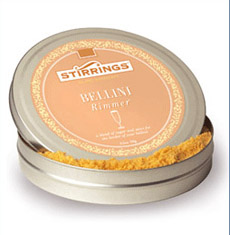 Framboise. The original kir royale. Drop a fresh raspberry into the glass. Rim with Urban Accents Cosmo Rimmer or Stirrings Pomegranate Rimmer. Framboise. The original kir royale. Drop a fresh raspberry into the glass. Rim with Urban Accents Cosmo Rimmer or Stirrings Pomegranate Rimmer. - Mango Juice or Puree. A new classic. Rim with Stirrings Mango Rimmer.
- Peach Juice or Nectar. The classic Bellini is made with white peach juice. Rim with Stirrings Bellini Rimmer.
- Pear Nectar. Serve with a slice of fresh pear. Rim with Stirrings Apple Martini or Urban Accents Appletini Rimmer.
Rimmers can be purchased at Stirrings.com and UrbanAccents.com.
Cava, Champagne, & Prosecco
Your choice of sparkling wines can vary. Don’t crack open the Dom Perignon for these drinks—the reason to drink fine champagnes is to enjoy every nuance of their toasty, caramel tones. In a cocktail, all of those flavors will be covered up by the mixers. Inexpensive champagnes work best here.
We use a variety of sparklers:
- Champagnes: Both domestic and imported
- Cava: Spanish sparkling wines
- Prosecco: Italian sparkling wine used for Bellinis
There are delicious sparkling wines made in other countries as well. Consult with your local wine merchant. For $10-$12 a bottle—sometimes even less—you should be able to get something very tasty. The objective is not to find the cheapest wine, but wine good enough to serve straight; in fact, so that those who don’t want the cocktail can enjoy it on its own merit.
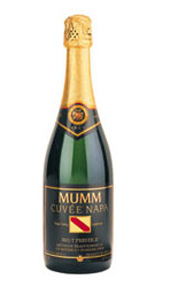 |
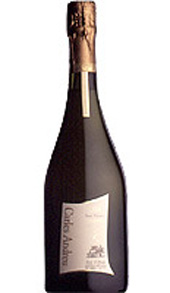 |
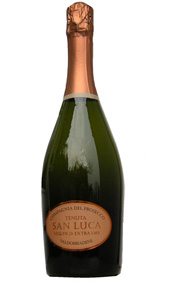 |
| California: Sparkling Wine |
Spain: Cava |
Italy: Prosecco |
We’d love to hear about your own favorite sparkling “mixers.” Click here to drop us a note. |




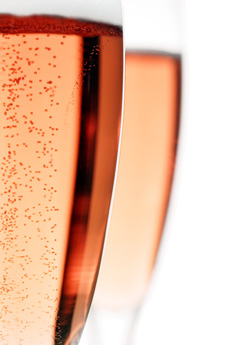
 Framboise. The original kir royale. Drop a fresh raspberry into the glass. Rim with Urban Accents Cosmo Rimmer or Stirrings Pomegranate Rimmer.
Framboise. The original kir royale. Drop a fresh raspberry into the glass. Rim with Urban Accents Cosmo Rimmer or Stirrings Pomegranate Rimmer. 

